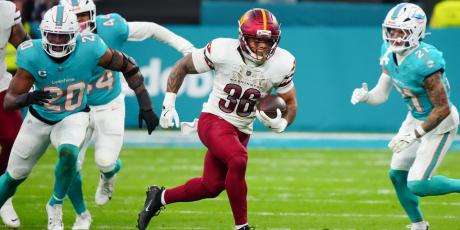Best Ball: Using the Schedule to Your Advantage

Schedule analysis in best ball is all about grinding edges to boost your advance rate or provide correlation to your playoff-week bets. The best way to view the schedule is as a tiebreaker during your drafts. However, there are some clear suboptimal choices when examining past years of Best Ball Mania (BBM) data. With that in mind, let’s start with bye weeks for your QB and TE rooms before digging into playoff week game stacking.
QB Bye Weeks
Teams with QB rooms where every QB had the same bye week advanced to the playoffs only 14.1% of the time last season. That’s a significant gap compared to our 16.7% benchmark (2 out of every 12 teams in a draft advance). This is particularly important to avoid if you take an elite QB and your goal is to end the draft with only two QBs. But there’s not much else to learn for two-QB builds. Things get more interesting with three QBs.
The table below shows all five possible scenarios for the bye weeks of your three quarterbacks. And they’re listed from worst to first in terms of BBMV advance rate. As mentioned above, don’t be one of the 1% of teams that draft all of their QBs with the same bye week. From there, I organized teams by the order in which they drafted their QBs. So, if you drafted Kyler Murray first, then J.J. McCarthy, and finally Jaxson Dart, then your first QB is Murray, your second McCarthy, and your third Dart.
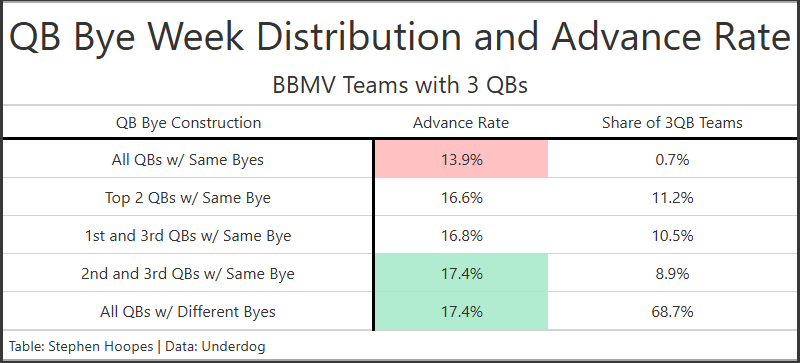
Your worst option is to draft your first two QBs with the same bye week. And that is closely followed by drafting your first and third QBs with the same bye week. This is actually pretty intuitive. In this example, you’ve spent decent draft capital on Kyler Murray. You’re confident that the combination of Murray’s rushing ability and an improved connection with Marvin Harrison Jr. will hit your lineup in most weeks. What you’ve done in the two scenarios described above is remove one of your outs for QB points when Murray is on bye. You’ve locked yourself into having to take either just McCarthy’s points or just Dart’s points in that individual week.
Alternatively, you got a 0.6-0.8% advance rate advantage last year when the bye weeks of both your second and third QBs did not match your QB1. When Murray is on bye, you’ve doubled your outs by being able to take the higher score between McCarthy and Dart. And even if both McCarthy and Dart had the same bye week, you weren’t harmed to the same extent because Murray’s floor is so much safer than your second and third QBs. An easy rule of thumb to remember is to avoid drafting a QB with the same bye week as your QB1. That works for both two- and three-QB builds.
TE Bye Weeks
Teams with TE rooms where every TE had the same bye week earned the same poor advance rate as the QB position, making the playoffs only 14.1% of the time. And the trend for three-TE builds is similar to that of QBs, but with one key difference. The table below shows the same five scenarios for the bye weeks of your three tight ends.
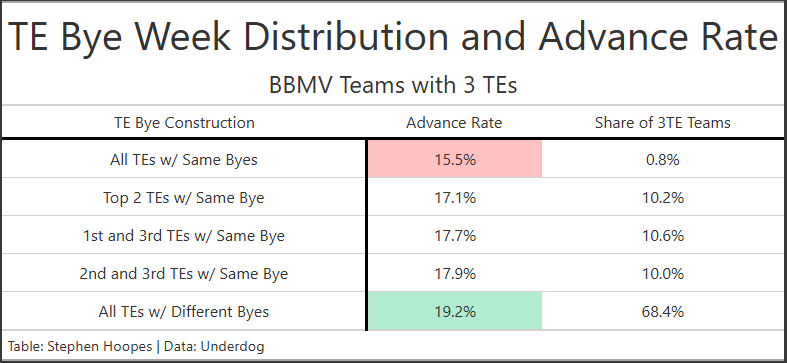
Just like with QBs, drafting all three of your tight ends with the same bye week is clearly sub-optimal, and there is a significant advance rate gap compared to any other construction. But what’s most interesting about TEs is the clear advantage of drafting three unique bye weeks. I think the reason is related to the typical draft capital spent on the position in three-TE builds. 55.0% of all drafters took two TEs last season. However, 68.8% of teams that took an “elite” TE used a two-TE build, with an elite TE just being one you drafted in the first five rounds.
So, the typical three-TE build avoided one of the most expensive TEs and attacked the position through volume instead of early capital. But that means the team didn’t have a blue-chip player who was going to hit their lineup in most weeks. By drafting all three players with different bye weeks, you’re guaranteed at minimum two outs for TE points every week throughout the season (injuries aside). That is particularly important for TEs as they earn an outsized share of their fantasy points from touchdowns that can be fluky on a weekly basis. So, the rule of thumb for TEs is to always draft players with unique bye weeks.
Final Bye Week Thoughts
Before moving on to playoff game stacking, I wanted to include some final motivation for caring about bye weeks. The graph below is a bit hypnotic and has lots of pretty colors, but stick with me. Each colorful line shows the distribution of points by your standing in a 12-person draft. For example, the dark blue line all the way on the right represents the scores of teams that finished first among the twelve teams in their draft.
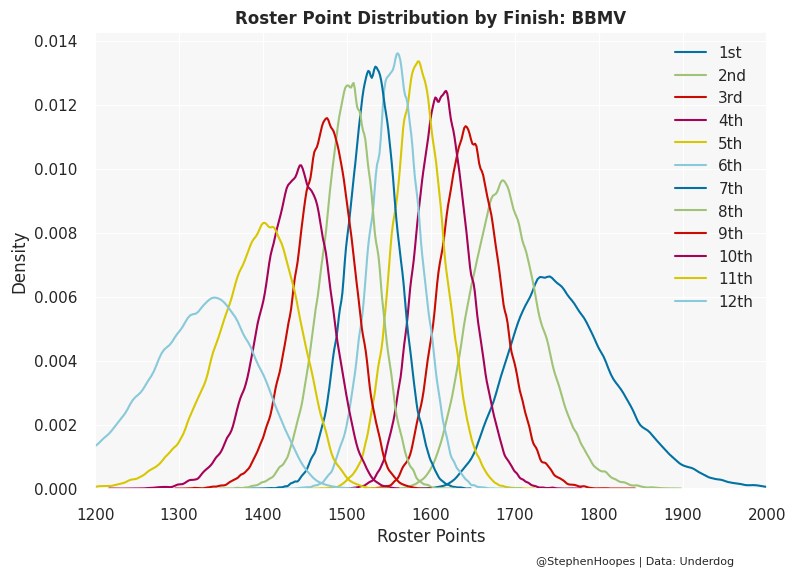
What I want you to focus on is the two lines directly to the left of that dark blue line. The green and red lines represent the second and third-place finishers. On average, second-place teams scored 43 more points than third-place teams last season. Now, 43 points is more than any individual QB or TE will typically score in a week. But what you’ll notice on the graph is that the red third-place line overlaps a lot with the green second-place line. And that’s because the standard deviation of scores in this range is about 40 points. There is a very reasonable chance that one additional week of QB or TE scoring is the difference between you advancing to the playoffs or just missing out. Friends don’t let friends miss the playoffs because they drafted a QB or TE room with matching bye weeks.
Playoff Game Stacking
All of the money in best ball is won during the playoff weeks, which are Weeks 15-17. I’m going to speak out of both sides of my mouth here. On one side, we’re generally very bad at predicting what will happen in any game that will be played seven months from now. On the other side, this is quite literally the game we’re playing. With that in mind, the table below shows every team’s schedule from Weeks 15-17. If a matchup is highlighted in green, it means the projected game total is 47 points or higher on DraftKings. Similarly, red highlighted matchups have game totals of 43 points or below. If you’re like me and want to save a copy of this to your phone, you should be able to here.

I think focusing on teams with plus playoff matchups is completely reasonable. The Bengals and Buccaneers are the only teams with 47+ point game totals in every playoff week. But the primary use of the above table in my mind is correlating bets that you made early in the draft. For example, if you loaded up on the Commanders’ passing game with Jayden Daniels and Terry McLaurin, taking Jake Ferguson around ADP is a way to bet on a high-scoring game environment where Ferguson hopefully winds up in the endzone.
The above is a good example of how I’m defining a game stack. That is, two or more players on one NFL team and one or more players on that team’s opponent. In prior years, game-stacking Week 17 was correlated with higher playoff advance rates. And that doesn’t really make any sense. Why would drafting players based on the schedule in Week 17 help you advance after Week 14? The theory went that the type of drafter who paid attention to Week 17 game-stacking was relatively sharper than the typical drafter. Well, that drafter had a rough BBMV. Teams that ignored Week 17 correlation entirely advanced to the playoffs about 18.0% of the time, and each additional game stack lowered your playoff advance rate by about 1.0%.
So, the advance rates here are more indicative of the kind of drafter rather than Week 17 correlation hurting your playoff odds. For example, teams that drafted Saquon Barkley were 31% more likely to have zero Week 17 game stacks compared to the rest of the field. Yet, it wasn’t all bad news for the game stackers. They had an edge in Week 17, which is the entire point of the exercise. The graph below shows points scored in the final of BBMV, sorted by the number of Week 17 game stacks. Drafters with two or more game stacks averaged 1.3 more points than those with zero or one game stacks, with similar patterns for Weeks 15 and 16. It’s a small sample and a small edge, but that’s the game we play.
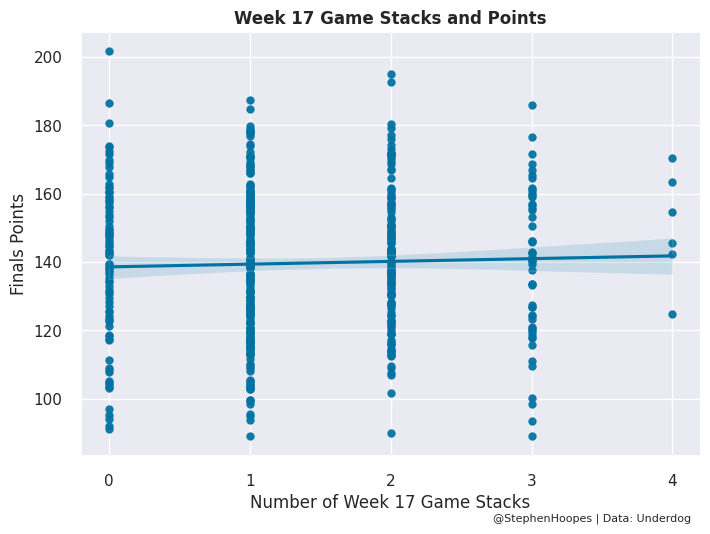
Final Schedule Thoughts
I had two other schedule-adjacent thoughts I wanted to share. They both touch on the optimal time during the draft season to try different strategies. The first is when to use two vs three-QB builds. Going into this, I thought the opportunity cost of a third QB in May, when we have less information about depth charts, would be lower than it is in August. That isn’t borne out in the data. The advance rate edge of three QBs was 0.8% in drafts from May through July. But that edge nearly doubled to 1.5% in August. Perhaps the point of drafting early in the summer is to capture closing line value and build teams that won’t be available to us in August? With that in mind, a third QB in May takes away another chance to hit on a WR or RB that will skyrocket up boards in training camp.
In the same vein, I thought that zero RB builds would be better options in August when we have a clearer idea of the RB depth charts. Again, the data tells the opposite story. I’m defining the zero RB strategy as taking zero RBs through round seven. With that definition, zero RB had an extremely tough BBMV. The combination of historic WR injuries, RB health, and a league-wide shift away from explosive pass attempts made early-round RB the dominant strategy last season. But zero RB drafts were especially bad later in the summer. From May-July, zero RB teams advanced 8.9% of the time; that dropped to 5.8% in August.
Bottom Line
• Teams that drafted all of their QBs or TEs with the same bye week had an advance rate 2.6% below average.
• The optimal QB bye week strategy is to avoid drafting a QB with the same bye week as your QB1. That works for both two- and three-QB builds.
• The optimal TE bye week strategy is to always draft TEs with unique bye weeks.
• While Week 17 game stacking hurt advance rates last year, there’s no reason for that to be the case going forward. And it provided a small edge in the finals, where the money is won.
• Opposite of my initial instinct, two-QB builds and zero RB performed better earlier in the draft season than they did in August.








